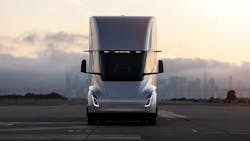When picking the fleet of the future, choose wisely
By the end of the decade, fleets are poised to have far more electric vehicles to manage and maintain. According to Statista, worldwide medium-duty EVs will more than quadruple from now until 2025, and then nearly double (to 302,000 units) from then to 2026. In the heavy-duty sector, there’s just under 2,000 electric trucks now; by 2026 there will be 22,000. From there, it’s presumed exponential growth will ensue.
This leaves little time for commercial vehicle operators to decide what their individual fleet of the future should look like. The important thing to remember is that there is probably no one “holy grail” to get you through this climate crusade. Like Indiana Jones, you must “choose wisely,” as the shiniest object—or one with the most government incentives—might not make sense for your application.
First off, there’s two big reasons to not procrastinate: the carrot and stick brandished by the federal government. The carrot is all the available incentives via the Infrastructure Investment and Jobs Act and Inflation Reduction Act (IRA). These pieces of legislation include billions in investments and incentives to purchase battery-electric and fuel-cell electric vehicles. The IRA specifically allows up to a $7,500 tax credit for light-duty commercial vehicles (14,000 lb. GVWR) and $40,000 per medium- and heavy duty (>14,000 lb. GVWR).
Meanwhile, the stick is the Environmental Protection Agency (EPA)—which plans to tighten greenhouse gas emission standards for model year 2027 and beyond “for subsectors where electrification is advancing at a more rapid pace,” which will likely impact buses, delivery trucks, and short-haul tractors. Heavy-duty vehicles may also get new GHG emissions standards for MY 2030.
But, if I had to guess, the combination of government ineptitude/corruption paired with a fragile grid will not support the rate of electrification politicians are aiming for. So, perhaps sticking with a diesel platform and implementing biodiesel makes the most sense for your application while also reaching net emission targets. A study from the Diesel Technology Forum and Stillwater Associates of medium- and heavy-duty trucks in 10 northeastern states found using “100% renewable diesel resulted in three times larger cumulative GHG reductions by 2032 than the EV scenarios.
“Using B20—a 20% blend of biodiesel with 80% petroleum diesel—provided about the same cumulative GHG reduction,” the DTF noted. Plus, the IRA did also include some token tax credits for renewable biofuels.
On the other hand, the shiniest object might work out for larger fleets, such as Pepsi, which recently received the first of the 100 Tesla Semis it ordered. The Semi’s range is 300 to 500 miles, depending on the battery configuration, and that is the sweet spot for regional hauls. The sleek design is also on brand for the Pepsi Generation and works as an eye-catching rolling billboard, although arguably not as much as a harrier jet.
For a more grounded alternative, Freightliner, Volvo, and Kenworth’s electric trucks might not have as long a range or Tesla’s mystique, but they have proven track records and much wider service networks. A Pitt Ohio driver on a pickup-and-delivery route I spoke with is already in love with his Volvo VNR Electric for its smooth ride and quiet operation.
Ultimately, the unfamiliar fuel-cell electric vehicles might make the most sense in the near future. The FCEVs being developed now have a longer range than BEVs and don’t generate emissions. The problem is that producing hydrogen takes a lot of energy. Green hydrogen, processed using renewables, is gaining momentum, though. The infrastructure law includes $1 billion for a Clean Hydrogen Electrolysis Program that cuts green hydrogen costs and the Department of Energy’s Hydrogen Shot program is working to reduce green hydrogen cost from $5/kg to $1/kg in a decade.
During a recent visit to green hydrogen producer Plug Power’s innovation center in Rochester, New York, I received a glimpse of a possible zero-emission future firsthand. Along with seeing how Plug makes license plate-sized membrane electrode assemblies for their fuel cells and electrolyzers, Plug representatives detailed how its electrolyzers produce liquid hydrogen using hydroelectric power from Niagara Falls. Plug also makes tankers to haul the liquid hydrogen (which is colder than liquid nitrogen), fuel cells (for forklifts and facilities), and light commercial vans through a joint venture with Renault. The company has several projects across the globe and expects to produce 500 tons of liquid green hydrogen per day in 2025, up from 9.1 tons in 2022. Revenue also is projected to climb from $1.4 billion next year to $20 billion in 2030.
Andy Marsh, Plug Power president and CEO, told me hydrogen benefited most from the IRA, and that the incentives will help accelerate Plug’s cost proposition. “Every time we doubled the number of units in the field, our costs declined by about 25%,” Marsh said. Plug is also working to slash the amount of iridium in its electrolyzers, as the global chase for rare earth metals could get ugly.
“Hydrogen is really the Swiss Army knife of this transition to renewable energy,” Marsh offered. “We’re going to help the world get to net zero.”
This solution has found buy-in from large fleets, including Amazon, Walmart, and Home Depot. FreezPak, a New Jersey-based cold chain logistics provider, has used Plug’s hydrogen-powered forklifts since 2014. Co-CEO David Saoud said the hydrogen forklifts take only 90 seconds to refill, versus 10 hours for electric, allowing for higher productivity. He can’t wait for hydrogen trucks to become available, as he already has the infrastructure at the cold storage facilities, and indicated FreezPak will adopt whatever FCEV is first available, leasing diesel trucks until that happens.
About the Author

John Hitch
Editor-in-chief, Fleet Maintenance
John Hitch is the award-winning editor-in-chief of Fleet Maintenance, where his mission is to provide maintenance leaders and technicians with the the latest information on tools, strategies, and best practices to keep their fleets' commercial vehicles moving.
He is based out of Cleveland, Ohio, and has worked in the B2B journalism space for more than a decade. Hitch was previously senior editor for FleetOwner and before that was technology editor for IndustryWeek and and managing editor of New Equipment Digest.
Hitch graduated from Kent State University and was editor of the student magazine The Burr in 2009.
The former sonar technician served honorably aboard the fast-attack submarine USS Oklahoma City (SSN-723), where he participated in counter-drug ops, an under-ice expedition, and other missions he's not allowed to talk about for several more decades.


